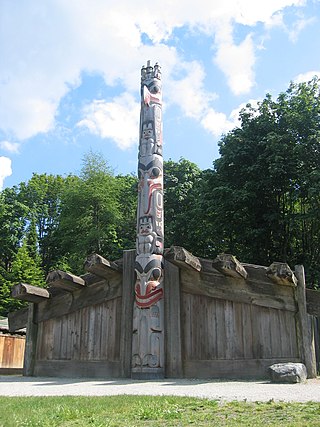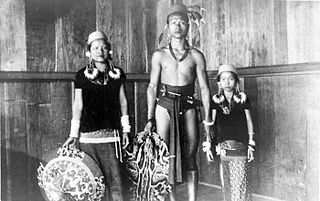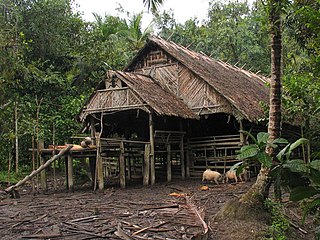The culture of East Timor reflects numerous cultural influences, including Portuguese, Roman Catholic, and Malay, on the indigenous Austronesian cultures in East Timor.

A longhouse or long house is a type of long, proportionately narrow, single-room building for communal dwelling. It has been built in various parts of the world including Asia, Europe, and North America.

The culture of Indonesia has been shaped by long interaction between original indigenous customs and multiple foreign influences. Indonesia is centrally-located along ancient trading routes between the Far East, South Asia and the Middle East, resulting in many cultural practices being strongly influenced by a multitude of religions, including Buddhism, Christianity, Confucianism, Hinduism, and Islam, all strong in the major trading cities. The result is a complex cultural mixture, often different from the original indigenous cultures.

Taman Mini Indonesia Indah is a culture-based recreational area located in East Jakarta, Indonesia. Since July 2021, it is operated by PT Taman Wisata Candi Borobudur, Prambanan, dan Ratu Boko, a subsidiary of the state-owned tourism holding company Injourney. It was operated by Yayasan Harapan Kita, a foundation established by Siti Hartinah, the first lady during most of the New Order and wife of Suharto, and run by Suharto's descendants since his death until 2021. It has an area of about 147 hectares. The project cost some US$ 26 million.

Mentawai people are the native people of the Mentawai Islands about 100 miles from West Sumatra province, Indonesia. They live a semi-nomadic hunter-gatherer lifestyle in the coastal and rainforest environments of the islands and are also one of the oldest tribes in Indonesia. The Mentawai population is estimated to be about 64,000. The Mentawai tribe is documented to have migrated from Nias – a northern island – to the Mentawai islands, living in an isolated life for centuries until they encountered the Dutch in 1621. The ancestors of the indigenous Mentawai people are believed to have first migrated to the region somewhere between 2000 and 500 BCE. The Mentawai language belongs to the Austronesian language family. They follow their own animist belief system called Arat Sabulungan, that links the supernatural powers of ancestral spirits to the ecology of the rainforest. When the spirits are not treated well or forgotten, they might bring bad luck like illnesses and haunt those who forgot them. Mentawai also have very strong belief towards objects they think are holy. The people are characterized by their heavy spirituality, body art and their tendency to sharpen their teeth, a cultural practice tied to Mentawai beauty ideals. Mentawai tend to live in unison and peace with the nature around them because they believe that all things in nature have a form of spiritual essence.

Pondok Indah Mall, abbreviated as PIM, is a large shopping mall complex located in the Pondok Indah suburb of South Jakarta, Indonesia. In January 2017, it was recognised by Forbes as one of the top five shopping malls in Jakarta. The Pondok Indah Mall complex comprises three large main buildings, the older 3-storey PIM1 and the 5-storey PIM2, and the newest building PIM3. PIM 1 and 2 are interconnected via two elevated multi-storey pedestrian walkways, which are also tenanted by specialty shops. PIM3, which was officially opened in 2021, is interconnected to the other two buildings by a walkway as well.

The architecture of Indonesia reflects the diversity of cultural, historical, and geographic influences that have shaped Indonesia as a whole. Invaders, colonizers, missionaries, merchants, and traders brought cultural changes that had a profound effect on building styles and techniques.

The Omo sebua is a traditional house style of the Nias people from Nias island, Indonesia. They are built only for the houses of village's chiefs. Situated in the centre of a village, omo sebua are built on massive ironwood piles and have towering roofs. Nias culture, with former frequent inter-village warfare, has made the design of omo sebua impregnable to attack. The houses' sole access is through a narrow staircase with a small trap door above. The steeply pitched roofs can reach 16 metres in height. Apart from a strong defense against enemies, omo sebua have proven earthquake resistance.

The Kenyah people are an indigenous, Austronesian-speaking people of Borneo, living in interior North and East Kalimantan, Indonesia and Sarawak, Malaysia.

The Islamic Arts Museum Malaysia is a museum in Kuala Lumpur, Malaysia. It was officially opened on 12 December 1998. The museum is the largest museum of Islamic arts in Southeast Asia with more than seven thousands artifacts from the Islamic world.

Rumoh Aceh is a type of traditional vernacular house found in the Aceh Province in Indonesia. It is basically a wooden pile dwelling. Rumoh Aceh is the largest and tallest of all vernacular house types found in Aceh Province, the others are the Rumoh Santeut and the Rangkang.

Uma houses are traditional vernacular houses found on the western part of the island of Siberut in Indonesia. The island is part of the Mentawai islands off the west coast of Sumatra.

The Indonesian island of Sumatra is the sixth largest island in the world. The rich ethnic diversity and historical heritage in Sumatra is reflected in the range of architectural styles in the island. The vernacular style is the native Sumatran ethnic groups architecture of dwellings, while the Hindu-Buddhist architecture reflected through the cultural historical heritage of candis built in Sumatra. The third wave is Islamic architecture adopted in mosques and palace in Sumatra, especially in Aceh, North Sumatra, and Malay cultural sphere in the island.

Rumah adat are traditional houses built in any of the vernacular architecture styles of Indonesia, collectively belonging to the Austronesian architecture. The traditional houses and settlements of the several hundreds ethnic groups of Indonesia are extremely varied and all have their own specific history. It is the Indonesian variants of the whole Austronesian architecture found all over places where Austronesian people inhabited from the Pacific to Madagascar each having their own history, culture and style.

Kiryat HaLeom, also known as Kiryat HaUma and referred to in English as the National Quarter, is the official label of a complex in central Jerusalem that includes Kiryat HaMemshala, the Knesset (parliament), Sacher Park, the Menorah Garden, Wohl Rose Park and Binyanei HaUma convention center. It was traditionally considered to be the northern part of the Givat Ram neighborhood.

New Indies Style is a modern architectural style used in the Dutch East Indies between the late 19th century through pre-World War II 20th century. New Indies Style is basically early modern (western) architecture, which applies local architectural elements such as wide eaves or prominent roof as an attempt to conform with the tropical climate of Indonesia.

The Sumbanese traditional house refers to the traditional vernacular house of the Sumba people from the island of Sumba, Lesser Sunda Islands, Indonesia. A Sumbanese house is characterized by a high-pitched central peak in its roof and a strong connection with the spirits or marapu.

Mosque architecture in Indonesia refers to the architectural traditions of mosques built in the archipelago of Indonesia. Initial forms of the mosque, for example, were predominantly built in the vernacular Indonesian architectural style mixed with Hindu, Buddhist or Chinese architectural elements, and notably didn't equip orthodox form of Islamic architectural elements such as dome and minaret. Vernacular architectural style varies depending on the island and region.
COMO Hotels and Resorts is a Singapore-based company that operates hotels in Australia, Bhutan, Indonesia, Italy, the Maldives, Thailand, Turks and Caicos, the United Kingdom and the United States. The company was founded by Christina Ong in 1991.

















